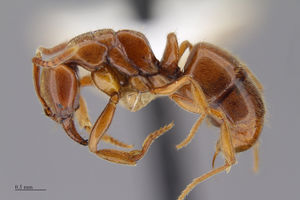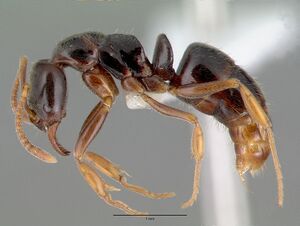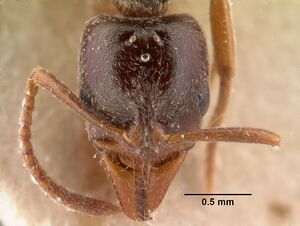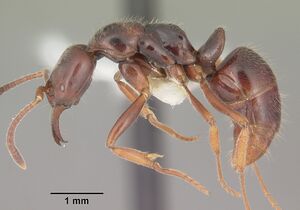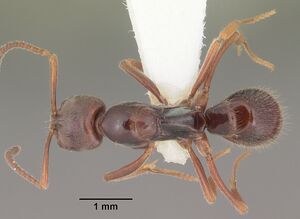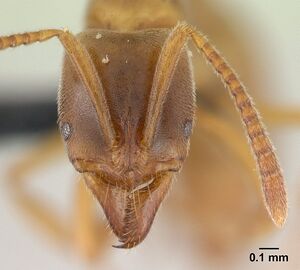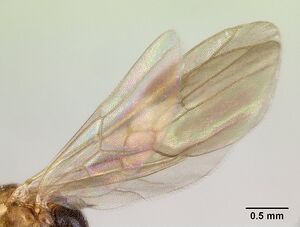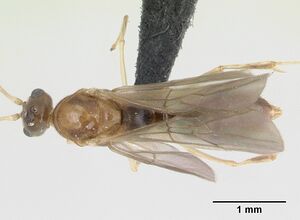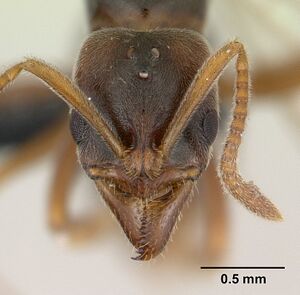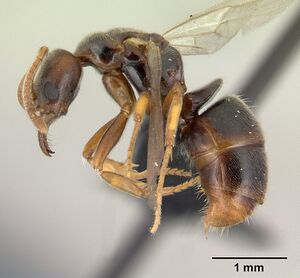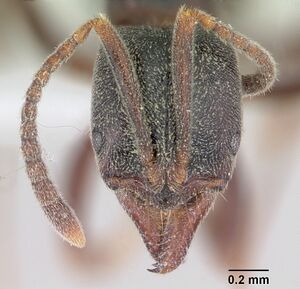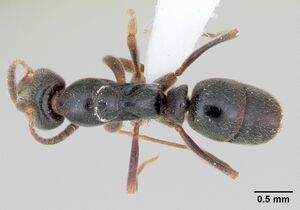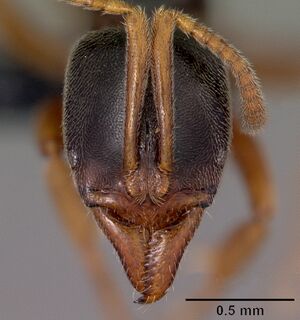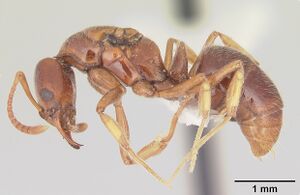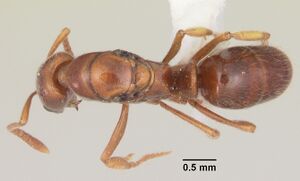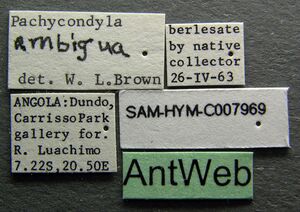AntWiki: The Ants --- Online
Identification
Keys including this Species
Distribution
Latitudinal Distribution Pattern
Latitudinal Range: 17.266667° to -30.5°.
Afrotropical Region: Comoros, Ivory Coast, Kenya, Mozambique, Nigeria, Saudi Arabia, Sierra Leone (type locality), Uganda, United Republic of Tanzania, Yemen.
Malagasy Region: Madagascar, Mayotte.
Distribution based on AntMaps
Distribution based on AntWeb specimens
Check data from AntWeb
Countries Occupied
| Number of countries occupied by this species based on AntWiki Regional Taxon Lists. In general, fewer countries occupied indicates a narrower range, while more countries indicates a more widespread species.
|

|
Estimated Abundance
| Relative abundance based on number of AntMaps records per species (this species within the purple bar). Fewer records (to the left) indicates a less abundant/encountered species while more records (to the right) indicates more abundant/encountered species.
|

|
Biology
Castes
Phylogeny
See Phylogeny of Ponerinae for details.
Nomenclature
The following information is derived from Barry Bolton's Online Catalogue of the Ants of the World.
- ambigua. Pachycondyla ambigua André, 1890: 316 (q.) SIERRA LEONE.
- Type-material: holotype queen.
- Type-locality: Sierra Leone: (no further data).
- Type-depository: MNHN.
- Combination in Euponera (Brachyponera): Emery, 1901a: 47;
- combination in Pachycondyla: Brown, in Bolton, 1995b: 302;
- combination in Mesoponera: Schmidt, C.A. & Shattuck, 2014: 110.
- Status as species: Dalla Torre, 1893: 32; Emery, 1901a: 49; Emery, 1911d: 84; Wheeler, W.M. 1922a: 777; Collingwood, 1985: 240; Bolton, 1995b: 302; Collingwood & Agosti, 1996: 310; Collingwood & van Harten, 2005: 74; Hita Garcia, et al. 2013: 220; Borowiec, L. 2014: 141.
- Distribution: Burundi, Cameroon, Democratic Republic of Congo, Ghana, Iran, Ivory Coast, Kenya, Saudi Arabia, Sierra Leone, Uganda, Yemen.
Description
References
- André, E. 1890. Matériaux pour servir à la faune myrmécologique de Sierra-Leone (Afrique occidentale). Rev. Entomol. (Caen) 9: 311-327 (page 316, queen described)
- André, E. 1890. Matériaux pour servir à la faune myrmécologique de Sierra-Leone (Afrique occidentale). Rev. Entomol. (Caen) 9: 311-327.
- Borowiec, L. 2014. Catalogue of ants of Europe, the Mediterranean Basin and adjacent regions (Hymenoptera: Formicidae). Genus (Wroclaw) 25(1-2): 1-340.
- Brown, W. L., Jr. 1995a. [Untitled. Taxonomic changes in Pachycondyla attributed to Brown.] Pp. 302-311 in: Bolton, B. A new general catalogue of the ants of the world. Cambridge, Mass.: Harvard University Press, 504 pp. (page 302, Combination in Pachycondyla)
- Brown, W. L., Jr. 1995a. [Untitled. Taxonomic changes in Pachycondyla attributed to Brown.] Pp. 302-311 in: Bolton, B. A new general catalogue of the ants of the world. Cambridge, Mass.: Harvard University Press, 504 pp. (page 302, Combination in Pachycondyla)
- Egbon, I.N., Osabuohien, I.P. 2022. First checklist, species richness and diversity of leaf-litter dwelling ants (Hymenoptera: Formicidae) in ancient Benin moat, Nigeria. Animal Research International 19(3): 4634–4642.
- Emery, C. 1901b. Notes sur les sous-familles des Dorylines et Ponérines (Famille des Formicides). Ann. Soc. Entomol. Belg. 45: 32-54 (page 47, Combination in Euponera (Brachyponera))
- Esteves, F.A., Fisher, B.L. 2021. Corrieopone nouragues gen. nov., sp. nov., a new Ponerinae from French Guiana (Hymenoptera, Formicidae). ZooKeys 1074, 83–173 (doi:10.3897/zookeys.1074.75551).
- Schmidt, C.A. & Shattuck, S.O. 2014. The higher classification of the ant subfamily Ponerinae (Hymenoptera: Formicidae), with a review of ponerine ecology and behavior. Zootaxa 3817, 1–242 (doi:10.11646/zootaxa.3817.1.1).
- Weber, N. A. 1942b. New doryline, cerapachyine and ponerine ants from the Imatong Mountains, Anglo-Egyptian Sudan. Proc. Entomol. Soc. Wash. 44: 40-49 (page 46, fig. 6 worker described)
- Belshaw R., and B. Bolton. 1994. A survey of the leaf litter ant fauna in Ghana, West Africa (Hymenoptera: Formicidae). Journal of Hymenoptera Research 3: 5-16.
- Belshaw R., and B. Bolton. 1994. A survey of the leaf litter ant fauna in Ghana, West Africa (Hymenoptera: Formicidae). Journal of Hymenoptera Research. 3: 5-16.
- Borowiec L. 2014. Catalogue of ants of Europe, the Mediterranean Basin and adjacent regions (Hymenoptera: Formicidae). Genus (Wroclaw) 25(1-2): 1-340.
- Emery C. 1911. Hymenoptera. Fam. Formicidae. Subfam. Ponerinae. Genera Insectorum 118: 1-125.
- Fisher B. L. 1997. Biogeography and ecology of the ant fauna of Madagascar (Hymenoptera: Formicidae). Journal of Natural History 31: 269-302.
- Fisher B. L. 2003. Formicidae, ants. Pp. 811-819 in: Goodman, S. M.; Benstead, J. P. (eds.) 2003. The natural history of Madagascar. Chicago: University of Chicago Press, xxi + 1709 pp.
- Fisher B. L. 2004. Diversity patterns of ants (Hymenoptera: Formicidae) along an elevational gradient on Monts Doudou in southwestern Gabon. Memoirs of the California Academy of Sciences 28: 269-286.
- Fisher, B. 2002. Ant diversity patterns along an elevational gradient in the Reserve Speciale de Manongarivo, Madagascar. in Gautier, L. and S.M. Goodman, editors, Inventaire Florestique et Faunistique de la Reserve Speciale de Manongarivo (NW Madagascar)
- Fisher, B.L. and H.G. Robertson. 2002. Comparison and Origin of Forest and Grassland Ant Assemblages in the High Plateau of Madagascar (Hymenoptera: Formicidae). Biotropica 34(1):155-167.
- Garcia F.H., Wiesel E. and Fischer G. 2013.The Ants of Kenya (Hymenoptera: Formicidae)Faunal Overview, First Species Checklist, Bibliography, Accounts for All Genera, and Discussion on Taxonomy and Zoogeography. Journal of East African Natural History, 101(2): 127-222
- IZIKO South Africa Museum Collection
- Kone M., S. Konate, K. Yeo, P. K. Kouassi, and K. E. Linsenmair. 2012. Changes in ant communities along an age gradient of cocoa cultivation in the Oumé region, central Côte dIvoire. Entomological Science 15: 324339.
- Kouakou L. M. M., K. Yeo, K. Ouattara, W. Dekoninck, T. Delsinne, and S. Konate. 2018. Investigating urban ant community (Hymenoptera: Formicidae) in port cities and in major towns along the border in Côte d’Ivoire: a rapid assessment to detect potential introduced invasive ant species. Journal of Animal and Plant Sciences 36(1): 5793-5811.
- Kouakou L. M. M., W. Dekoninck, M. Kone, T. Delsinne, K. Yeo, K. Ouattara, and S. Konate. 2018. Diversity and distribution of introduced and potentially invasive ant species from the three main ecoregions of Côte d’Ivoire (West Africa). Belgian Journal of Zoology 148 (1): 83–103.
- Lévieux J. 1972. Les fourmis de la savane de Lamto (Côte d'Ivoire): éléments de taxonomie. Bulletin de l'Institut Fondamental d'Afrique Noire. Série A. Sciences Naturelles 34: 611-654.
- Medler J. T. 1980: Insects of Nigeria - Check list and bibliography. Mem. Amer. Ent. Inst. 30: i-vii, 1-919.
- Ravelomanana A., and B. L. Fisher. 2013. Diversity of ants in burned and unburned grassland , and dry deciduous forest in the Beanka Reserve, Melaky Region, western Madagascar. Malagasy Nature 7: 171-183.
- Ross S. R. P. J., F. Hita Garcia, G. Fischer, and M. K. Peters. 2018. Selective logging intensity in an East African rain forest predicts reductions in ant diversity. Biotropica 1-11.
- Wheeler W. M. 1922. Ants of the American Museum Congo expedition. A contribution to the myrmecology of Africa. VIII. A synonymic list of the ants of the Ethiopian region. Bulletin of the American Museum of Natural History 45: 711-1004
- Yeo K., S. Konate, S. Tiho, and S. K. Camara. 2011. Impacts of land use types on ant communities in a tropical forest margin (Oumé - Cote d'Ivoire). African Journal of Agricultural Research 6(2): 260-274.
- Yeo K., and A. Hormenyo. 2007. A Rapid Survey of Ants in Ajenjua Bepo and Mamang River Forest Reserves, Eastern Region of Ghana. Pp 27-29. In McCullough, J., P. Hoke, P. Naskrecki, and Y. Osei-Owusu (eds.). 2008. A Rapid Biological Assessment of the Ajenjua Bepo and Mamang River Forest Reserves, Ghana. RAP Bulletin of Biological Assessment 50. Conservation International, Arlington, VA, USA.




